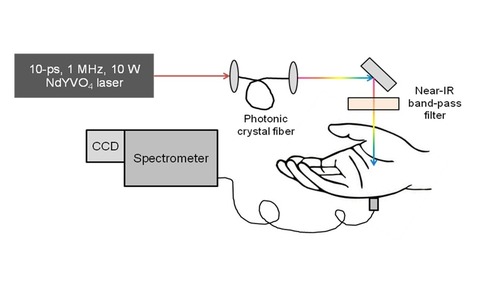
The Andor iDus Deep Depletion CCD camera was used to develop a computer model for assessing tissue transmission spectra.
The recent emergence of in vivo optical imaging probes holds out the promise of rapid, inexpensive, and non-invasive medical screening and diagnostics for a wide range of diseases.
These advances in optical spectroscopic characterisation are also critical for the success of laser surgery where it is essential to know exactly the laser fluence delivered to a specific organ and the optimal laser excitation conditions for maximum tissue probing depth.
Now, an international team led by Igor Meglinski and Vladislav Yakovlev has developed a computer model for assessing tissue transmission spectra that they hope will change the identification of conditions for optical diagnostics and laser surgery.
The team also believes it can play a vital role in the successful deployment of facial recognition security systems.
To build and verify the computer model, Georgi Petrov of the BME Department at Texas A&M University measured transmission rates for different parts of the human body in the 500 to 950 nm spectral range, using an Andor iDus Deep Depletion CCD camera.
“We needed high sensitivity, both in the VIS and NIR regions, and a deep depletion CCD to avoid all the etalonning effects that would affect our measurements. We chose Andor’s iDus-401 BR-DD because it offered high quantum efficiency in the near infrared with zero etalonning combined with a high dynamic range and good detector linearity.”
According to Antoine Varagnat, Product Specialist at Andor, “We have witnessed accelerating interest in non-invasive optical screening systems over the last few years.
“For instance, a joint US-Dutch team led by Anita Mahadevan-Jansen and Takashi Nagaoka’s Japanese team have both used Andor detectors, a Deep-Depletion iDus CCD for Raman spectroscopy and an iXon EMCCD for Reflectance Spectroscopy respectively, to power their experimental probes for malignant melanoma and skin cancer screening.
“The work of Meglinski and Yakovlev, in discovering a way to model the functional properties of human skin and other tissues, opens up new ways to identify optimal conditions for optical diagnostics.
“Similarly, modelling optical variations associated with physiological changes, such as blood oxygenation, holds out the hope of novel, non-invasive techniques to monitor patients 24/7, especially those in intensive care.”




